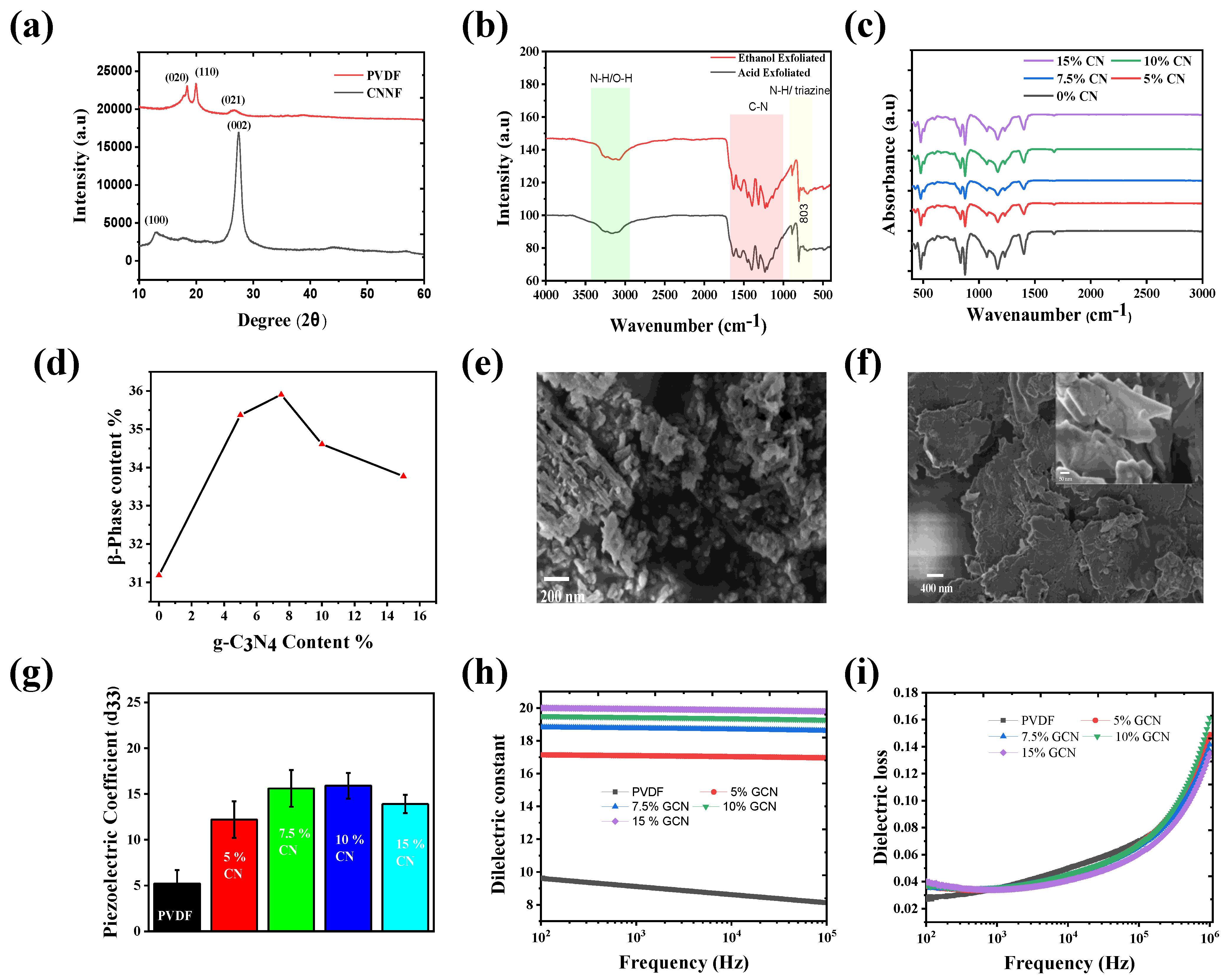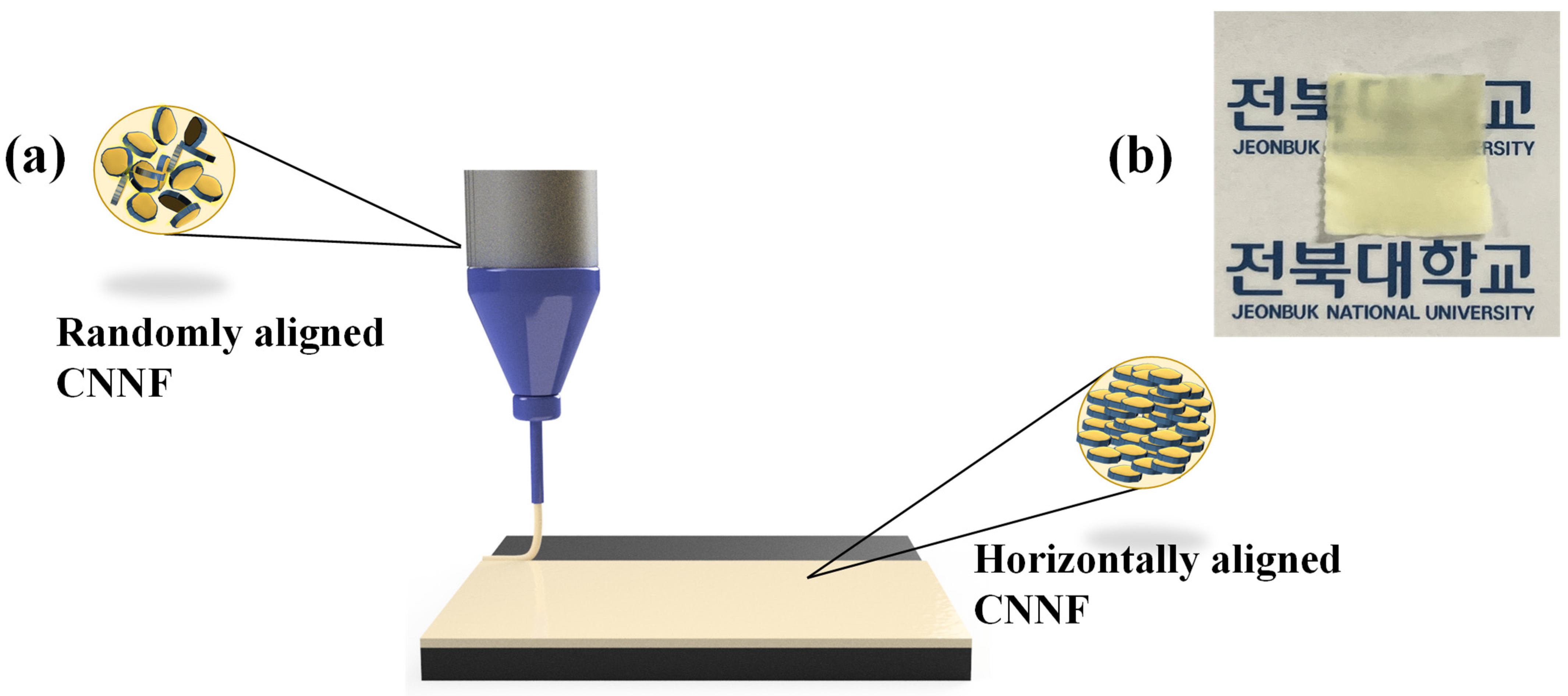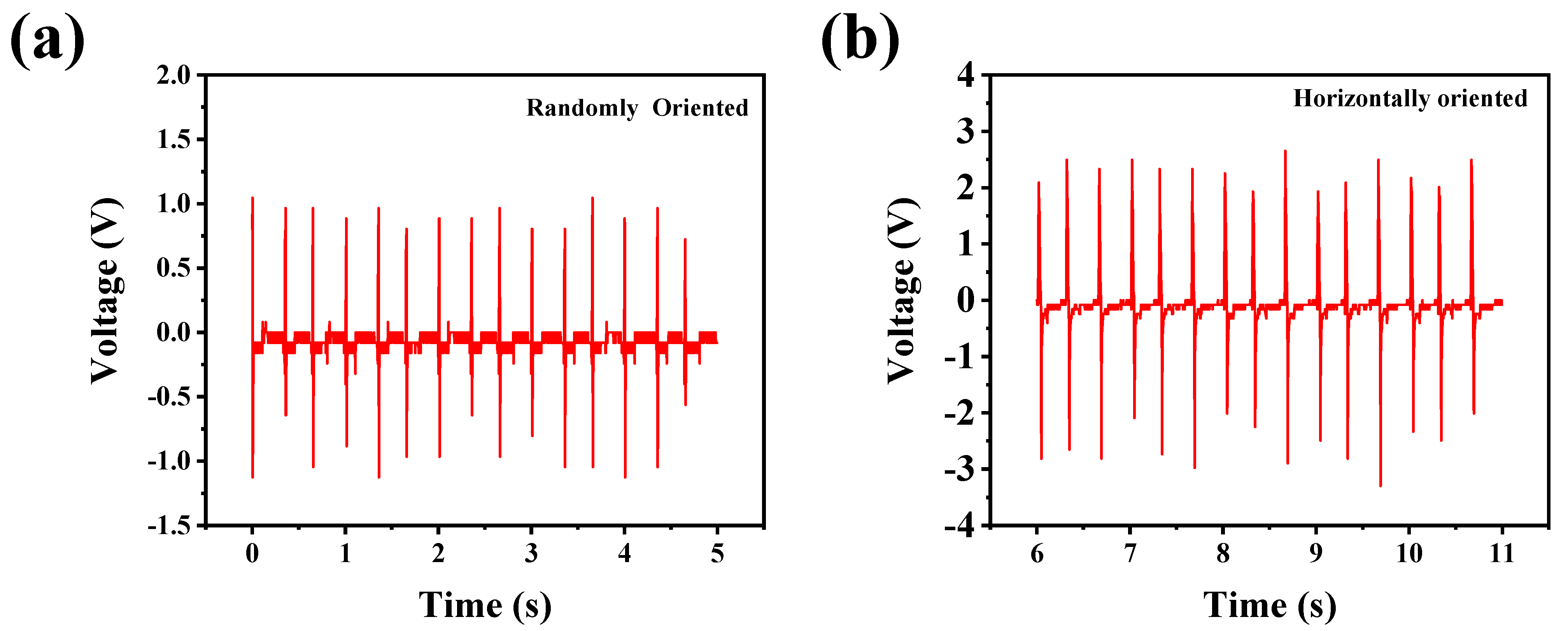Enhanced Flexible Piezoelectric Nanogenerators Using Ethanol-Exfoliated g-C3N4/PVDF Composites via 3D Printing for Self-Powered Applications
Abstract
:1. Introduction
2. Material and Method
2.1. Materials
2.2. Synthesis of GCN Nanoflakes (CNNFs)
2.3. Piezoelectric Film Fabrication
2.4. Characterizations
3. Result and Discussion

Piezoelectric Performance
4. Impact of Printing Parameters
5. Effects of UV Light
6. Application
7. Conclusions
Supplementary Materials
Author Contributions
Funding
Data Availability Statement
Conflicts of Interest
References
- You, C.Y.; Hu, B.F.; Xu, B.R.; Zhang, Z.Y.; Wu, B.M.; Huang, G.S.; Song, E.-M.; Mei, Y.-F. Foldable-circuit-enabled miniaturized multifunctional sensor for smart digital dust. Chip 2022, 1, 100034. [Google Scholar] [CrossRef]
- Chen, Y.; Kang, Y.; Zhao, Y.; Wang, L.; Liu, J.; Li, Y.; Liang, Z.; He, X.; Li, X.; Tavajohi, N.; et al. A review of lithium-ion battery safety concerns: The issues, strategies, and testing standards. J. Energy Chem. 2021, 59, 83–99. [Google Scholar] [CrossRef]
- Giordano, M.; Mayer, P.; Magno, M. A Battery-Free Long-Range Wireless Smart Camera for Face Detection. In Proceedings of the 8th International Workshop on Energy Harvesting and Energy-Neutral Sensing Systems, New York, NY, USA, 16 November 2020; Association for Computing Machinery: New York, NY, USA, 2020; pp. 29–35. [Google Scholar] [CrossRef]
- Chen, W.; Liang, J.; Yang, Z.; Li, G. A review of lithium-ion battery for electric vehicle applications and beyond. In Energy Procedia; Elsevier Ltd.: Amsterdam, The Netherlands, 2019; Volume 158, pp. 4363–4368. [Google Scholar] [CrossRef]
- Pawar, O.Y.; Patil, S.L.; Redekar, R.S.; Patil, S.B.; Lim, S.; Tarwal, N.L. Strategic Development of Piezoelectric Nanogenerator and Biomedical Applications. Appl. Sci. 2023, 13, 2891. [Google Scholar] [CrossRef]
- Bouhamed, A.; Binyu, Q.; Böhm, B.; Jöhrmann, N.; Behme, N.; Goedel, W.A.; Wunderle, B.; Hellwig, O.; Kanoun, O. A hybrid piezoelectric composite flexible film based on PVDF-HFP for boosting power generation. Compos. Sci. Technol. 2021, 208, 108769. [Google Scholar] [CrossRef]
- Bagheri, M.H.; Khan, A.A.; Shahzadi, S.; Rana, M.M.; Hasan, M.S.; Ban, D. Advancements and challenges in molecular/hybrid perovskites for piezoelectric nanogenerator application: A comprehensive review. Nano Energy 2024, 120, 109101. [Google Scholar] [CrossRef]
- Bairagi, S.; Ali, S.W. Investigating the role of carbon nanotubes (CNTs) in the piezoelectric performance of a PVDF/KNN-based electrospun nanogenerator. Soft Matter 2020, 16, 4876–4886. [Google Scholar] [CrossRef] [PubMed]
- Bai, X.; Wang, L.; Zong, R.; Zhu, Y. Photocatalytic activity enhanced via g-C3N4 nanoplates to nanorods. J. Phys. Chem. C 2013, 117, 9952–9961. [Google Scholar] [CrossRef]
- Patil, S.L.; Redekar, R.S.; Pawar, O.Y.; Kundale, S.S.; Sutar, S.S.; More, K.V.; Chavan, V.D.; Kim, D.-K.; Dongale, T.D.; Tarwal, N.L. Precursor-dependent resistive switching properties of nanostructured g-C3N4: Statistical and experimental investigations. J. Mater. Sci. Mater. Electron. 2023, 34, 155. [Google Scholar] [CrossRef]
- Bayan, S.; Bhattacharya, D.; Mitra, R.K.; Ray, S.K.; Ray, S.K. Self-powered flexible photodetectors based on Ag nanoparticle-loaded g-C3N4nanosheets and PVDF hybrids: Role of plasmonic and piezoelectric effects. Nanotechnology 2020, 31, 36. [Google Scholar] [CrossRef]
- Wang, R.C.; Lin, Y.C.; Chen, H.C.; Lin, W.Y. Energy harvesting from g-C3N4 piezoelectric nanogenerators. Nano Energy 2021, 83, 105743. [Google Scholar] [CrossRef]
- Khalifa, M.; Anandhan, S. PVDF Nanofibers with Embedded Polyaniline-Graphitic Carbon Nitride Nanosheet Composites for Piezoelectric Energy Conversion. ACS Appl. Nano Mater. 2019, 2, 7328–7339. [Google Scholar] [CrossRef]
- Li, N.; Gao, X.; Su, J.; Gao, Y.; Ge, L. Metallic WO2-decorated g-C3N4 nanosheets as noble-metal-free photocatalysts for efficient photocatalysis. Chin. J. Catal. 2023, 47, 161–170. [Google Scholar] [CrossRef]
- Patnaik, S.; Behera, A.; Parida, K. A review on g-C3N4/graphene nanocomposites: Multifunctional roles of graphene in the nanohybrid photocatalyst toward photocatalytic applications. Catal. Sci. Technol. 2021, 11, 6018–6040. [Google Scholar] [CrossRef]
- Zhang YPan, Q.; Chai, G.; Liang, M.; Dong, G.; Zhang, Q.; Qiu, J. Synthesis and luminescence mechanism of multicolor-emitting g-C3N4 nanopowders by low temperature thermal condensation of melamine. Sci. Rep. 2013, 3, 1943. [Google Scholar] [CrossRef]
- Nguyen, P.A.; Nguyen, T.K.A.; Dao, D.Q.; Shin, E.W. Ethanol Solvothermal Treatment on Graphitic Carbon Nitride Materials for Enhancing Photocatalytic Hydrogen Evolution Performance. Nanomaterials 2022, 12, 179. [Google Scholar] [CrossRef] [PubMed]
- Khasim, S.; Pasha, A.; Lakshmi, M.; Panneerselvam, C.; Ullah, M.F.; Darwish, A.A.A.; Hamdalla, T.A.; Alfadhli, S.; Al-Ghamdi, S.A. Synthesis of g-C3N4/CuO Nanocomposite as a Supercapacitor with Improved Electrochemical Performance for Energy Storage applications. Int. J. Electrochem. Sci. 2022, 17, 220838. [Google Scholar] [CrossRef]
- Patil, S.L.; Pawar, O.Y.; Patil, H.S.; Sutar, S.S.; Kamble, G.U.; Kim, D.K.; Kim, J.H.; Kim, T.G.; Kamat, R.K.; Dongale, T.D.; et al. The g-C3N4-TiO2 nanocomposite for non-volatile memory and artificial synaptic device applications. J. Alloys Compd. 2023, 962, 171024. [Google Scholar] [CrossRef]
- Bera, B.; Das Sarkar, M. Piezoelectric Effect, Piezotronics and Piezophototronics: A Review. Imp. J. Interdiscip. Res. (IJIR) 2016, 2, 1407–1410. [Google Scholar]
- Yu, Y.; Liu, K.; Zhang, Y.; Xing, X.; Li, H. High Photocatalytic Activity of g-C3N4/La-N-TiO2 Composite with Nanoscale Heterojunctions for Degradation of Ciprofloxacin. Int. J. Environ. Res. Public Health 2022, 19, 4793. [Google Scholar] [CrossRef]
- Khalifa, M.; Mahendran, A.; Anandhan, S. Synergism of graphitic-carbon nitride and electrospinning on the physico-chemical characteristics and piezoelectric properties of flexible poly(vinylidene fluoride) based nanogenerator. J. Polym. Res. 2019, 26, 73. [Google Scholar] [CrossRef]
- Iqbal, N.; Afzal, A.; Khan, I.; Khan, M.S.; Qurashi, A. Molybdenum impregnated g-C3N4 nanotubes as potentially active photocatalyst for renewable energy applications. Sci. Rep. 2021, 11, 16886. [Google Scholar] [CrossRef] [PubMed]
- Liu, Y.; Shen, S.; Li, Z.; Ma, D.; Xu, G.; Fang, B. Mesoporous g-C3N4 nanosheets with improved photocatalytic performance for hydrogen evolution. Mater. Charact. 2021, 174, 111031. [Google Scholar] [CrossRef]
- Pattnaik, S.P.; Behera, A.; Martha, S.; Acharya, R.; Parida, K. Facile synthesis of exfoliated graphitic carbon nitride for photocatalytic degradation of ciprofloxacin under solar irradiation. J. Mater. Sci. 2019, 54, 5726–5742. [Google Scholar] [CrossRef]
- Cai, X.; Lei, T.; Sun, D.; Lin, L. A critical analysis of the α, β and γ phases in poly(vinylidene fluoride) using FTIR. RSC Adv. 2017, 7, 15382–15389. [Google Scholar] [CrossRef]
- Salimi, A.; Yousefi, A.A. FTIR studies of β-phase crystal formation in stretched PVDF films. Polym. Test 2003, 22, 699–704. [Google Scholar] [CrossRef]
- Lanceros-Méndez, S.; Mano, J.F.; Costa, A.M.; Schmidt, V.H. FTIR and DSC studies of mechanically deformed β-pvdf films. J. Macromol. Sci. Part B 2001, 40, 517–527. [Google Scholar] [CrossRef]
- Zhou, L.; Yang, T.; Fang, Z.; Zhou, J.; Zheng, Y.; Guo, C.; Zhu, L.; Wang, E.; Hou, X.; Chou, K.C.; et al. Boosting of water splitting using the chemical energy simultaneously harvested from light, kinetic energy and electrical energy using N doped 4H-SiC nanohole arrays. Nano Energy 2022, 104, 107876. [Google Scholar] [CrossRef]
- Xue, Y.; Yang, T.; Zheng, Y.; Wang, K.; Wang, E.; Wang, H.; Zhu, L.; Du, Z.; Wang, H.; Chou, K.-C.; et al. Heterojunction Engineering Enhanced Self-Polarization of PVDF/CsPbBr3/Ti3C2Tx Composite Fiber for Ultra-High Voltage Piezoelectric Nanogenerator. Adv. Sci. 2023, 10, 2300650. [Google Scholar] [CrossRef] [PubMed]
- Li, H.; Lee, H.B.; Kang, J.W.; Lim, S. Three-dimensional polymer-nanoparticle-liquid ternary composite for ultrahigh augmentation of piezoelectric nanogenerators. Nano Energy 2023, 113, 108576. [Google Scholar] [CrossRef]
- Sharma, C.; Gupta, M.K.; Badatya, S.; Srivastava, A.K.; Sathish, N. Blue light emitting piezoelectric few-layered borophene nanosheets for flexible nanogenerators. Commun. Mater. 2023, 4, 54. [Google Scholar] [CrossRef]
- Dashtizad, S.; Alizadeh, P.; Yourdkhani, A. Improving piezoelectric properties of PVDF fibers by compositing with BaTiO3-Ag particles prepared by sol-gel method and photochemical reaction. J. Alloys Compd. 2021, 883, 160810. [Google Scholar] [CrossRef]





| Acid Exfoliation | Ethanol Exfoliation | |
|---|---|---|
| Solution | Sulfuric acid (H2SO4) | Ethanol |
| Procedure time | 8 h | 1 h |
| Post-procedure | 1 h sonication + 1 h of heat treatment at 200 °C | Simple filtration + dry at 60 °C for 1 h |
| Cost | Higher | Lower |
| Environmental impact | Higher (due to acid use) | Lower |
| Material | Fabrication | Sample Dimension | Poling | Exfoliation | β-Phase% | Voltage | REF |
|---|---|---|---|---|---|---|---|
| g-C3N4 | Solution casting | 3 × 3 cm2 | no | No | Not provided | 1.6 V | [12] |
| PVDF/CNNS | Spin coating | 3.0 × 2.0 cm2 × 1 mm | no | Not provided | 10.2 V With 50 N 2.3 V Finger tapping | [11] | |
| PVDF/CNNS | Electrospinning | Not provided | 20 kV | Not provided | 82 % | ~7.5 V | [22] |
| PVDF/CNNS/PANI | Electrospinning | 3 × 3 cm2 × 0.05 mm | 18 kV | HCL | 96.9 % | ∼30 V | [13] |
| PVDF/CNNS | Direct ink writing | 2 × 2 cm2 × 0.083 mm | no | H2SO4 | 35.90 % | 6.5 with 40 N | Previous work |
| PVDF/CNNF | Direct ink writing | 2 × 2 cm2 × 0.083 mm | no | Ethanol exfoliation | 34 % | 6.7 V with 40 N | This work |
Disclaimer/Publisher’s Note: The statements, opinions and data contained in all publications are solely those of the individual author(s) and contributor(s) and not of MDPI and/or the editor(s). MDPI and/or the editor(s) disclaim responsibility for any injury to people or property resulting from any ideas, methods, instructions or products referred to in the content. |
© 2024 by the authors. Licensee MDPI, Basel, Switzerland. This article is an open access article distributed under the terms and conditions of the Creative Commons Attribution (CC BY) license (https://creativecommons.org/licenses/by/4.0/).
Share and Cite
Pawar, O.Y.; Lu, B.; Lim, S. Enhanced Flexible Piezoelectric Nanogenerators Using Ethanol-Exfoliated g-C3N4/PVDF Composites via 3D Printing for Self-Powered Applications. Nanomaterials 2024, 14, 1578. https://doi.org/10.3390/nano14191578
Pawar OY, Lu B, Lim S. Enhanced Flexible Piezoelectric Nanogenerators Using Ethanol-Exfoliated g-C3N4/PVDF Composites via 3D Printing for Self-Powered Applications. Nanomaterials. 2024; 14(19):1578. https://doi.org/10.3390/nano14191578
Chicago/Turabian StylePawar, Omkar Y., Baoyang Lu, and Sooman Lim. 2024. "Enhanced Flexible Piezoelectric Nanogenerators Using Ethanol-Exfoliated g-C3N4/PVDF Composites via 3D Printing for Self-Powered Applications" Nanomaterials 14, no. 19: 1578. https://doi.org/10.3390/nano14191578









